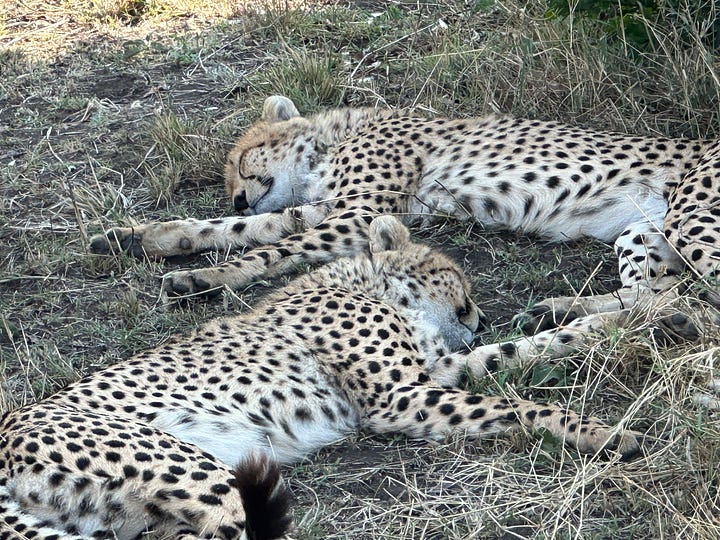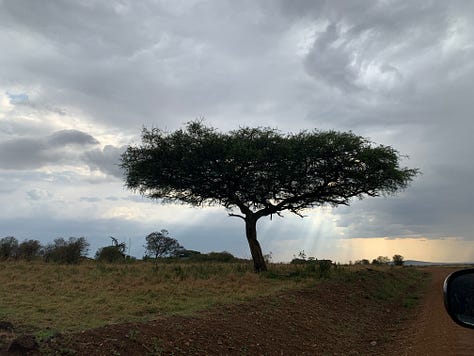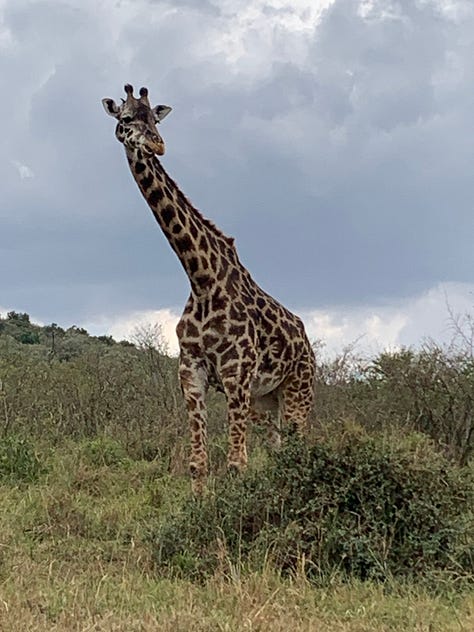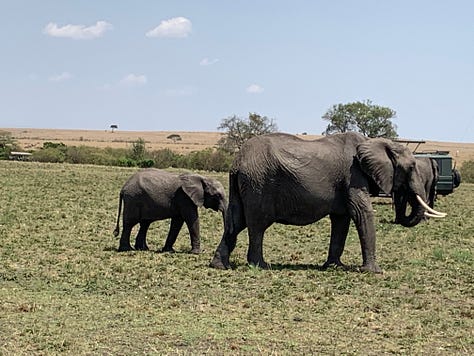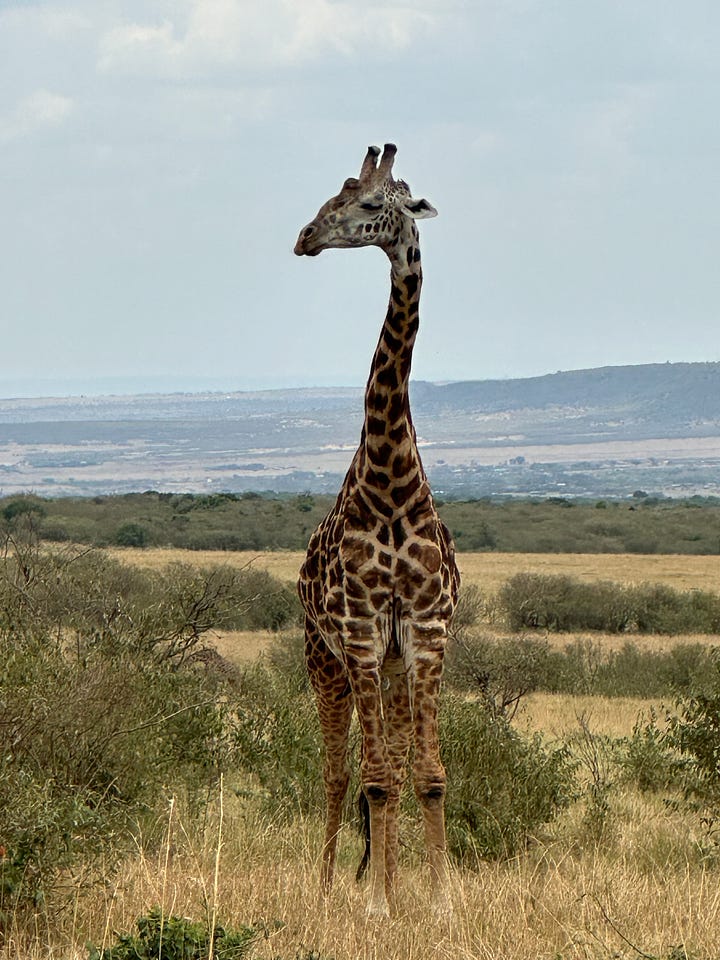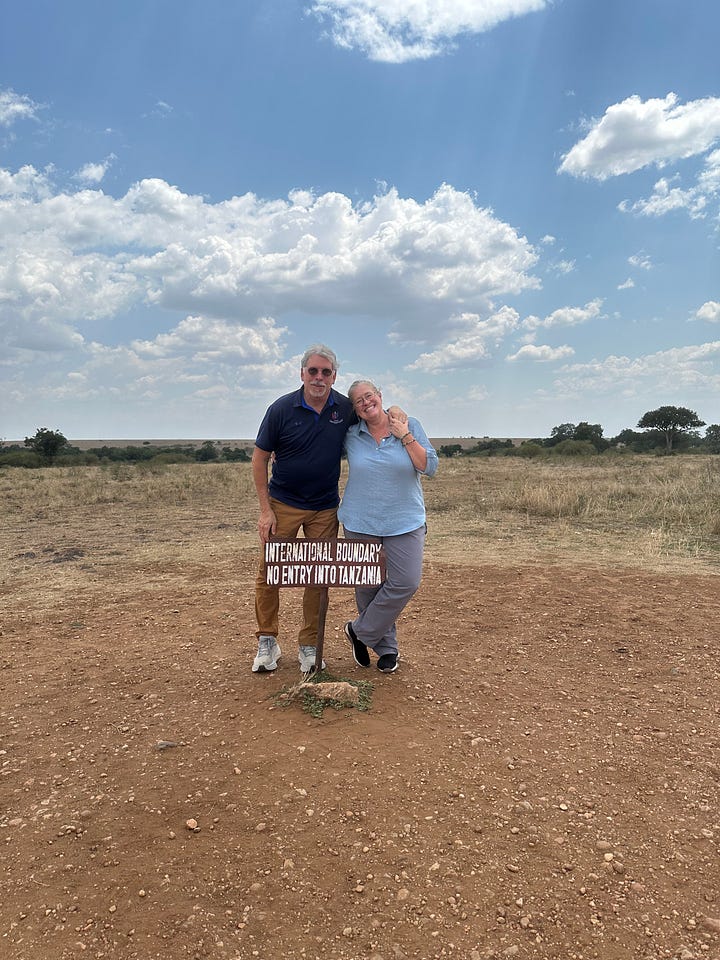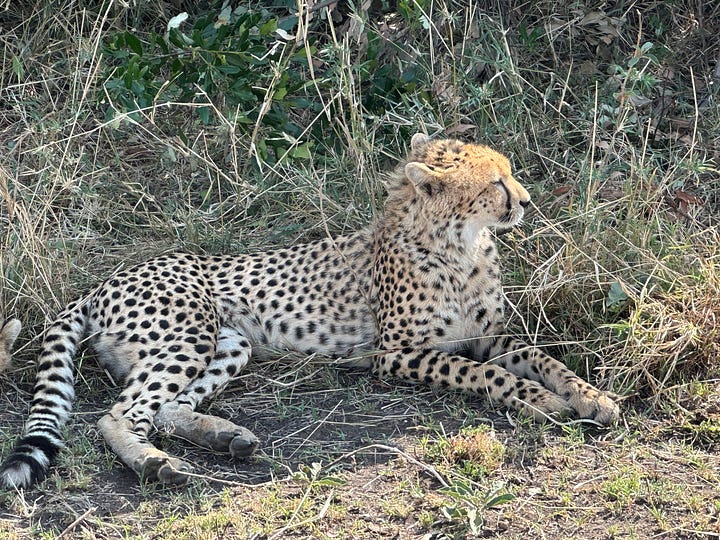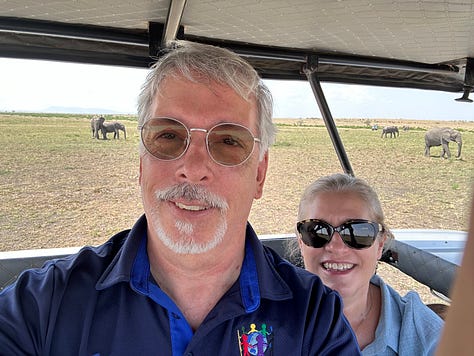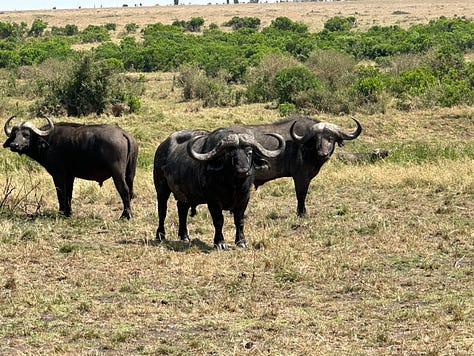Africa September 2024
Our Two-Week Trip Visiting Children's Homes in Rwanda, Uganda, Tanzania, and Kenya -- with a little safari in the Masai Mara tacked on the end.
This is a long post, describing our recent trip to Africa and the children’s homes we toured each day. This definitely falls under the Roaming category for my publication here on Substack. We travel a lot for fun and for our charity — this was a combination of both of those purposes.
I know not everyone will have the time or interest to read through to the end, but I wanted to show what we do through our charity The World Orphan Fund and to demonstrate how important it is that we visit projects we fund in person. That’s always been our promise to donors, that we won’t give financial support if we haven’t seen with our own eyes that the children are being well cared for and that funds will be used properly to care for the kids. Our team on this trip included my husband RJ (the founder of the charity), me, board member Steve Donovan, and volunteer Chris Shively. It had been a long 4+ years since we’ve visited East Africa, and it was beyond time that we headed back to check on projects and to visit other children’s homes in need where we might be of assistance. (There are also fun safari pictures at the end!!)
September 15 – 17
Madison, WI to Minneapolis to Amsterdam to Kigali, Rwanda to Bugesera, Rwanda
After a 28-hour journey from Madison, we arrived in Rwanda – the first stop on a four-country trip for the World Orphan Fund, which will also take us to Tanzania, Kenya, and Uganda.
We’re here to meet the incredible team at Hope for Children Ministries, Inc. in Bugesera, an organization dedicated to giving street children a safe place to live and sleep.
During the Rwandan genocide, 12-year-old Yves Nyamushanja was one of only 50 survivors out of 5,000 people in his community. Tragically, he lost his entire family and vowed never to return to this area. The impact of the genocide has been generational, and Yves came to believe that his survival could serve a greater purpose. So, he returned and, along with Julie Klosiewski of Wisconsin, founded Hope for Children.
Their mission is to help these children get off the streets and back into secure homes, but sadly, some have no safe place to go. With orphanages being illegal in Rwanda, Hope for Children is critical in providing care for those who need it most. They currently provide a home for 25 street children and have established a K-6 school that serves 400 poor children, offering two hot meals a day and a quality education. What we noticed right away is that the children all call Yves "Daddy." The little boy who lost his family to the genocide has become a father to 400 children.



The school allows mothers to work during the day while their children are in a safe environment. By addressing both education and nutrition, Hope for Children not only helps lift families out of poverty but also works to prevent future generations from experiencing the same hardships.
There are many more children on the streets who need a home—the police often bring in 15 children at a time seeking help. Unfortunately, they don’t have the space to accommodate these children, and that’s where we believe we can help. A new partially built dormitory for girls needs $15,000 to finish and provide a home for up to 40 girls. Additionally, a new boys' dormitory would cost another $25,000. The World Orphan Fund is committed to helping Hope for Children reach their goals and give as many as 55 more children the chance for a better life.
September 18 Entebbe to Arua to Adjumani, Uganda
After flying from Kigali, Rwanda to Entebbe, Uganda and overnighting there, we grabbed another flight to go the northern Ugandan town of Arua on the morning of the 18th. These are small planes with just a few seats, but this time it was a jet and not a prop plane so our flight time was shorter. Our drive time to get to our next children’s home visit was NOT short. After hours of navigating a “short cut” (mmhmm) on bumpy dirt roads (and me navigating an – um – interesting squatty potty experience), we took a ferry across the Blue Nile River. (GEOGRAPHY BREAK: The White Nile — which is also called the Victoria Nile — begins at Lake Victoria in Tanzania and flows north until it reaches Khartoum, Sudan, where it is joined by the Blue Nile which originates in Ethiopia, thus forming the main Nile River that flows northward to the Mediterranean Sea.)


Not long after that ferry crossing, we arrived at Cornerstone Children’s Home in Adjumani. We were welcomed by the children with a song and what felt like a parade to the entrance of the home. This always feels a little overwhelming as we exit our vehicle and walk with the kids.
Cornerstone operated in South Sudan for many years, until a devastating civil war forced the staff and 48 children to flee the violence and seek refuge here. (STATISTICS: Uganda hosts the highest number of refugees and asylum-seekers in Africa, with almost 1.7 million people mainly from South Sudan and the DRC.)
Today, Cornerstone provides a haven for 63 orphaned children and has a school that serves over 500 children from the local community. Their resilience in the face of unimaginable adversity was inspiring. We were alarmed to learn that many of the children are falling ill with typhoid and diarrhea, likely due to contaminated water. Before leaving, we collected a water sample for testing—which did indeed confirm that the water contains hazardous bacteria. We’re now working on plan to get their water safely treated.
Overnighting in Adjumani, we were so pleased to get into our hotel rooms to shower off the dust of the day and even with the intermittent power outages hot showers were achieved. We all met up in the dining room and perused the large menu only to be told by the waitress that the only item on the menu that evening was vegetable pizza. Ha ha – I guess I’ll have the veggie pizza. They did have my favorite bitter lemon soda called Crest. It was a win!
September 19 Adjumani to Gulu to Katikamu to Kavule to Entebbe
With flights to the northern part of Uganda only happening every three days or so, our trip back to southern Uganda would be by car (SUV actually) and our new friend, the wonderful Dr. Timothy Albers Ssemakula was providing this service. (More on his work in a little bit.)
We got an early 6 a.m. start and watched the sun come up on the way to our next stop. On the way we crossed the Blue Nile again over some rapids. It was a gorgeous location and we would have loved to take pictures, but the bridge is monitored by the Ugandan Army and photos are prohibited. With this being one of the only bridges for miles, it is considered a potential terrorist target – thus no photos.
Driving (nearly) the full length of Uganda allowed us to visit the St. Jude Children’s Home in Gulu. We were so glad that we were able to make this stop. It’s one of the most remarkable places we’ve encountered in the entire 13 years of The World Orphan Fund. The home cares for 69 orphaned children, each belonging to one of 13 family units. Every family has a dedicated mother who loves and tends to these children as if they were her own children. They live together in individual homes, each with its own kitchen and living room, fostering a warm, family-like environment.



Many of the children are severely disabled, some are orphans of the civil war (learn more about this war here), and others were abandoned. In heartbreaking circumstances, newborns arrive from the local hospital after childbirth complications that claimed their mother’s life.
Despite these profound challenges, the atmosphere at St. Jude’s is one of love, inclusion, and joy. It’s not just a refuge for the children who live there—it’s a beacon of hope for the entire community. The home provides accessible Christian education to local families (they have more than 400 students) and supports those caring for disabled children outside the home. Their work is not only preventing more children from becoming orphans, but it’s also enhancing the health and well-being of the community at large. Every child here is known by name, valued, and deeply loved. The special care and attention they receive is nothing short of inspiring.
The remainder of our drive back to Entebbe was uneventful, yet long. Along the way Dr. Tim showed us his medical center (Calvary Medical Centre in Kavule just outside of Kampala). Currently they’re operating in a small hospital, but a new adjacent three-story, larger hospital is nearly complete and will be a much-needed asset to the area where health care is so very, very scarce. (And when I say scarce – I really mean it! In the many hundreds of miles between Gulu and Kampala, Dr. Tim’s hospital is the only place that has modern medical equipment.) We appreciated learning about Dr. Tim’s efforts and were really impressed with his water accessibility projects, drilling wells in communities that do not have easy access to water. Nearly, 75% of all diseases in Uganda can be traced back to lack of clean water or proper sanitation, so this part of his ministry is a major health initiative. We also stopped at another orphanage where Dr. Tim helps out treating the kids who fall ill.
And speaking of water borne illness …. for most of the trip, we opt to stay in modern chain hotels to have access to meals that are the least likely to make us ill. It’s important to note that on these trips we only drink bottled water and use that to brush our teeth too. Even so, most of us never make it through an entire trip without eating or drinking something that gives us travelers’ diarrhea . . . luckily, it is usually never severe and can be managed with the trusty antibiotics we’ve been prescribed by our travel med doc. We’re also prescribed anti-malarial meds that we start before we leave and continue for seven days after we return.
So … we rely on known-brand hotels as much as possible. (But we cover all of our own costs on these trips!!) And we were happy to back at the beautiful Marriott on the shores of Lake Victoria for the night.
September 20 Entebbe to Nairobi to Kisumu
We flew from Entebbe to Nairobi to catch a flight to Kisumu, Kenya (also on the shores of Lake Victoria but on the other side) arriving in the mid-afternoon. We were joined enroute at the Nairobi airport by our friend Maurice Odhiambo. We partner with his Manna Ministries International team on many projects in and around Nairobi and Kisumu and further afield.
Today, we were delighted to return to Manna Academy and were greeted by 380 joyful students – 285 of whom are orphans. It’s an incredible place where orphans receive a Christian education, two hot meals daily, and a free school uniform (which is mandatory in Kenya). Their tuition is waived, ensuring that these children have access to the education they deserve. Back in 2020, we had the privilege of funding the construction of four new classrooms here, making it possible for more children to learn and thrive.



We also got to see the expanded vocational training program (tailoring and computer technology) and the secondary school that were expansions from when we were here in 2020.
We were happy to check into a hotel where we get to spend two whole nights, giving us a chance to get our laundry done!! (We travel with just carry-on luggage and tend to need a refresh of clean laundry midway through the trip.) We’re at the Sovereign Hotel, a delightful gem of a hotel that we’ve stayed at before.
September 21 – 22 Kisumu area (and then flights to Nairobi and Dar es Salaam, Tanzania)
The beginning of this story is sad – but there’s a happy ending.
Four years ago, we visited Mama Ngina Children’s Home—a government-run orphanage in Kisumu, Kenya. It left a lasting impression on us, but sadly, not a positive one. Inside the compound, we saw a bleak, dirt-filled yard with no toys, no playground equipment, and no color. The word "bleak" defined the entire experience. The children were neglected, not attending school, and the staff showed little engagement. There was no visible food preparation despite the approaching dinner hour, and the home had limited running water.
It devastated us. Tears flowed as we realized there was little we could do. Any effort to bring toys or supplies would likely have resulted in staff taking them for personal gain. We want to help every child we meet, but sometimes it feels impossible to convince our hearts of what our minds already know.
With some trepidation, we made a return visit, hoping to see if things had changed—and we are so grateful that we did.
The transformation was jaw-dropping. As we entered the gate, we were greeted by a paved yard and colorful cartoon characters painted on the walls. The new director, Tuli Tulitu, an energetic and intelligent woman, was hired in June 2023 and completely shifted the trajectory of this home. The orphanage had been shut down for six months to regroup, with the children temporarily relocated to other homes.
Today, everything is different—thank God! The home, now caring for many children with special needs, is filled with love and happiness. One of the key signs we look for in a nurturing home is how children gather around their caregivers, vying for attention in that joyful, natural way that shows they feel safe and cared for.

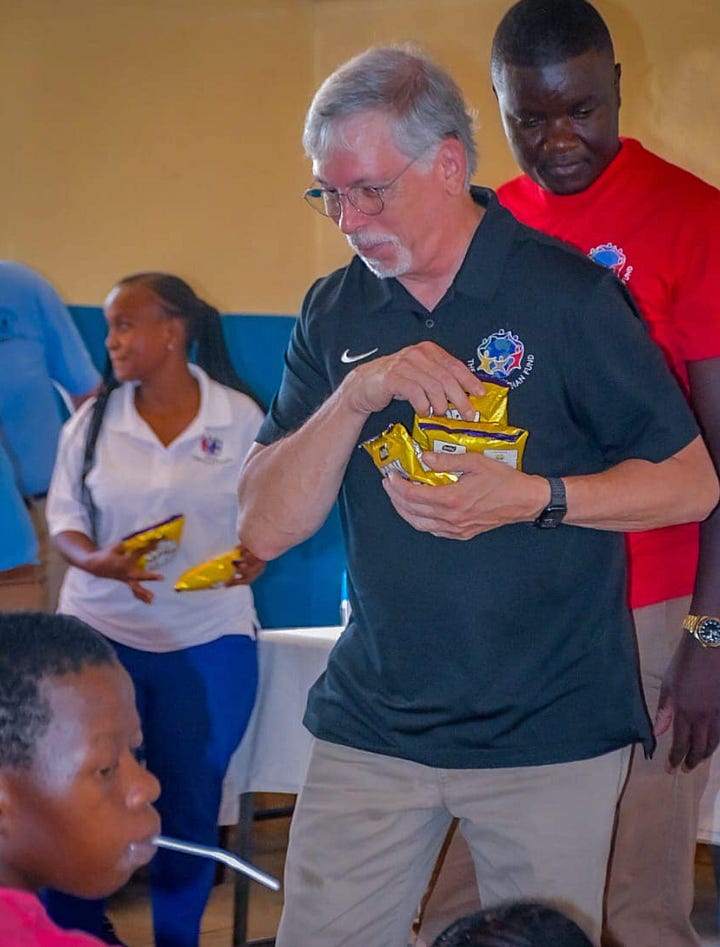


Every issue that broke our hearts on our first visit has been addressed—good food is cooking in the kitchen, clean clothes are folded, the plumbing works, beds are made with fresh bedding, and toys fill the space. But most importantly, the home is filled with love.
We are now working with the home to provide some basic needs like beds and shelving for the children’s clothing. We've also committed $1,920 to repair their van, which is essential for taking the children to school. The van had been in the shop, waiting for funds to fix it.
This remarkable transformation is a testament to the power of love-filled hearts to bring hope and lasting change to the lives of vulnerable children.
Other visits in the Kisumu area included two of the 48 orphanages supported by our emergency feeding program with our amazing partner Manna Ministries. From the outside, these homes resemble a patchwork of scavenged materials—corrugated metal, wood, and makeshift repairs barely holding them together. But inside, we were greeted by warmth, smiles, and the sweet sound of children singing us a welcome song. The love and care radiating from the caretakers made the condition of the structures seem secondary, but the reality of their living situation was hard to ignore.
The dormitories tell their own story—small, oppressively hot, and overcrowded. Two or three children share a single bed with thin blankets and worn sheets. Their few belongings are tucked into corners or squeezed into the framing of the building—there is no space for anything more. The outhouses are no better. Weather-beaten and leaning precariously, one had its roof torn off in a recent storm, but still, it serves the children as best it can.

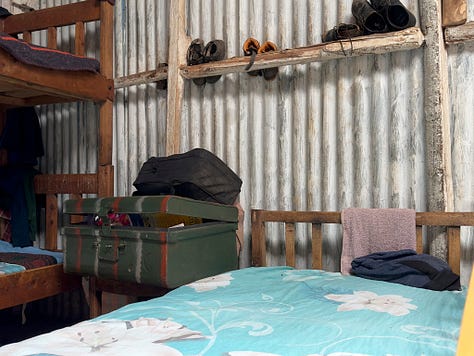




By any standard, these conditions would be considered sub-poverty, but these homes still manage to provide what truly matters: love and care. They survive on hope and determination.
One of these homes was founded by an extraordinary woman named Florence. She is a mother to 7 children, grandmother to 17, and great-great-grandmother to 8, yet in 2010, she opened her heart and home to even more. Over 80 children have passed through her doors. Some have gone on to college; others have built successful careers. Many return, not just to visit but to give back—a testament to the love, stability, and belonging Florence has created in a world that offered them little of either.
Our emergency feeding program is a lifeline for these children, ensuring that, despite everything, they have something to eat each day. Florence’s home, and so many others like it, may be humble, but they are filled with stories of triumph. They are a powerful reminder that love, care, and resilience can flourish even when material comforts are scarce.
September 23 – Dar es Salaam to Mbeya and back to Dar es Salaam
After a late arrival into Tanzania (and a crazy-long wait at passport control) we made it to our hotel for the night to be in position to fly out to southeastern city of Mbeya not far from the Zambia, DRC and Malawi borders with Tanzania. The flights in and out of this city are not frequent, but today there’s both a flight in and out that we’ll be taking. We’re visiting the Nuru Orphans Centre, a loving home for abandoned babies and orphaned children ranging from just 3 days old to 17 years. Upon our arrival, we were greeted by a chorus of joyful singing from the 34 children—an absolutely beautiful sight
Nuru was founded in 2005 by the remarkable Jason Fihavango and his late wife, Amanda, and it has become a sanctuary for children who have nowhere else to go. At 73 years old, Jason serves as the director and selflessly takes no salary. The 2 acres of land on which the home sits were graciously provided by the villagers, reflecting a deep commitment to caring for orphaned and abandoned babies.
Mary Hizmi, the home’s manager, is a gem—a smart, devoted, and humble woman. While soft-spoken, her strong leadership is immediately evident and inspiring. The support for Nuru is a beautiful tapestry of international kindness, including funds from the Japanese Embassy, which helped build two dormitories and a dining hall, and from Nuru Switzerland, which ensures the children are fed and cared for. A generous donor from Wisconsin covers Mary’s salary and the special dietary foods needed for malnourished children.




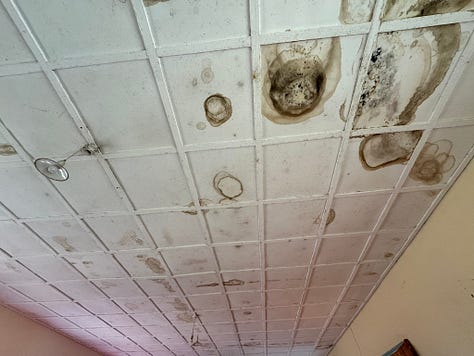

Nuru takes in some tough cases, showcasing the resilience of the human spirit. For instance, one little girl was found buried alive shortly after her birth and has shown incredible strength in her recovery after aspirating soil into her lungs, thanks to the loving care she received. Then there's Asha (pseudonym), who has been at Nuru for just three months. At only two years old, she had been sexually abused. But despite her trauma, when we locked eyes, Asha confidently walked over and raised her arms to be held. We held a lot of babies today.
Many of these children have called Nuru home since infancy, and if they have no parents, they proudly take the last name "Nuru," symbolizing their belonging to this caring family.
Recognizing the urgent need for repairs, we immediately committed to fixing a leaky roof in the girls' dormitory, which unfortunately drips water over their beds during the rainy season. Our visit was a heartwarming reminder of the strength and resilience these children embody and the profound impact that love and community support can have on their lives.
September 24 – Dar es Salaam back to Nairobi
Back in Nairobi—we finally leave the airport that we’ve been using as a hub for our travels. We visited Sprouting Again Children’s Home in Kitengela, Kenya, where we spent a few hours with nearly 100 beautiful kids. We were greeted with delightful songs, and a talented group of teens showcased their skills through rapping and dance performances, filling the air with energy and laughter. Together with our partner, Manna Ministries, we delivered food and supplies and served the children lunch.
While the home is clearly brimming with love and care, it faces significant challenges. The crowded dormitories are barely adequate, with some sleeping three to a bed. There are too few viable outhouses to serve all the children, and only one slide in the yard brings a bit of joy during their outdoor playtime. Providing adequate nutrition remains the biggest challenge, making our emergency deliveries a vital lifeline for these children.
While much work is needed here, the most important thing is that the children are safe and surrounded by love. I could have spent all day with the teen girls who were so much fun… bright personalities and big dreams for their futures!
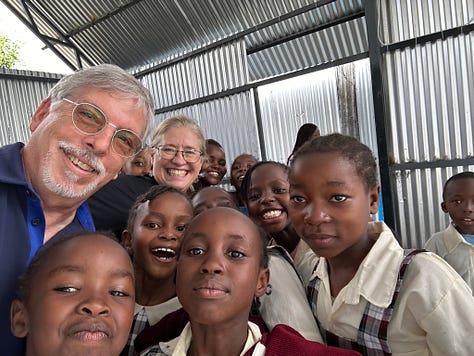





September 25 – Nairobi
Today, we had the joy of seeing Mum’s Love in person for the first time since its rebuild. Our visit was a celebration of this beautiful building and the lives it has transformed. The children performed dances and recited poetry, showcasing their incredible talents. A plaque dedicating the building was officially unveiled, and we had the privilege of serving the children a meal.
In 2020, there were 27 orphans; now, there are 47! Inside, the vibrant urban art painting created by a recovering drug addict who volunteered his time adds a wonderful touch to the space. Mum’s Love has become so much more than just an orphanage; the kitchen at the front of the building feeds 350 homeless people daily, significantly impacting the community. Alice (Mum) has also opened a school for 150 local children living in poverty, providing education through the third grade. Each child who finds a home here and every local student who steps into the classroom is given a chance to rewrite their story.

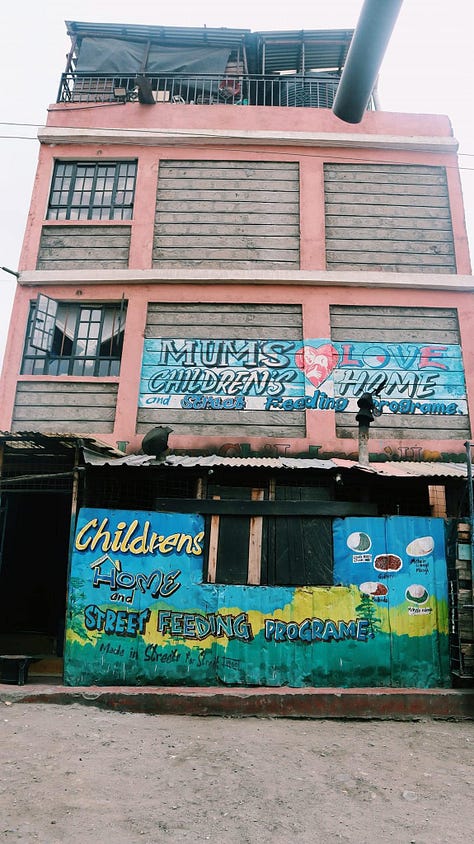
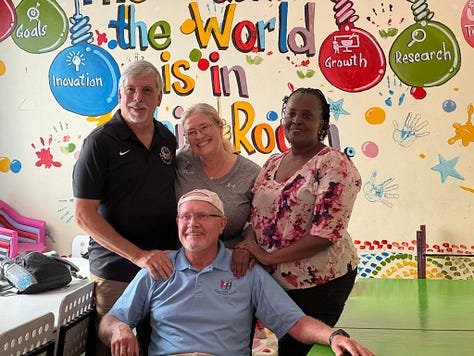
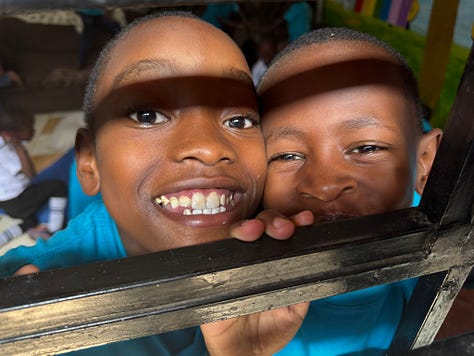
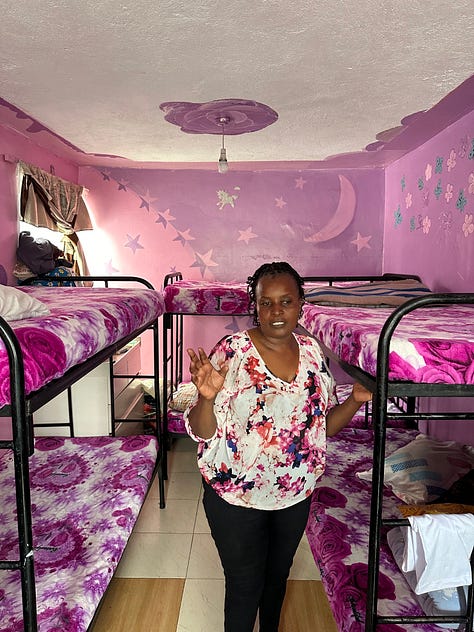


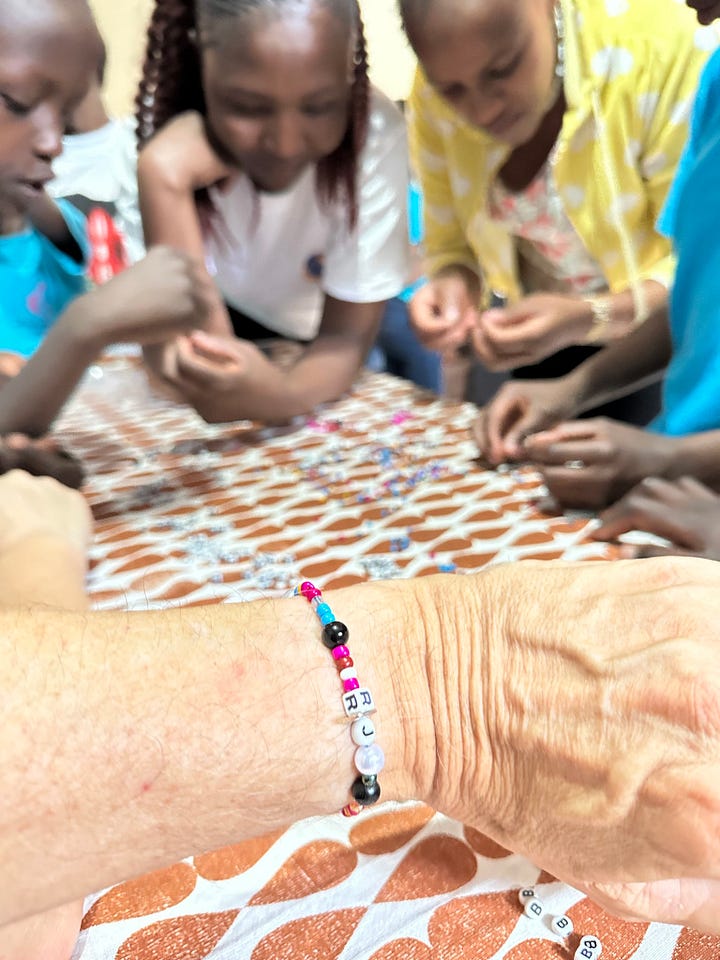
September 26 – In summary and … off to the Masai Mara for a safari
Over the past ten days, we’ve traveled thousands of miles, taken 13 flights, and visited nine children’s homes, a shelter for street children, and four schools in Tanzania, Rwanda, Uganda, and Kenya. We spent 30 hours driving, often on deeply rutted dirt roads. The locals jokingly call the experience an “African massage.” And as I mentioned earlier, as challenging as the travel is, it’s essential to our work, making sure the children are well cared for and being confident that any support we provide truly benefits them.
We met beautiful children, danced with them, held them, prayed with them, and reminded them they are loved. It’s a gift to be present, to laugh and share moments with them. But it’s also emotionally challenging at times. The more difficult moments are replayed in our minds. But the love and care radiating from the caretakers often softened the harsh reality of the children’s living conditions, even though the struggles the children face are impossible to ignore. We have already hit the ground running on these projects since our return.
But before we left this amazing part of the world, we decided to do something that we don’t often do . . . we tacked on some time to enjoy the beauty of Kenya and, in particular, the Masai Mara National Park in the southern part of the country. We spent a restful few days at Keekorok Lodge and went out on safari drives to view the animals . . . we saw so many lions, elephants, giraffe, zebras, wildebeests, hyenas, hippos (one even came right up to the lodge), crocodiles, cheetahs, warthogs, one elusive rhino!, gazelles, African buffalo, mongoose (mongeeses?? Ha ha), antelopes, bushbucks, elands, baboons, impalas, oribis, topis, and too many birds to list. It was a delight and a nice break from the fast travel we’d been doing. Enjoy the photos!
